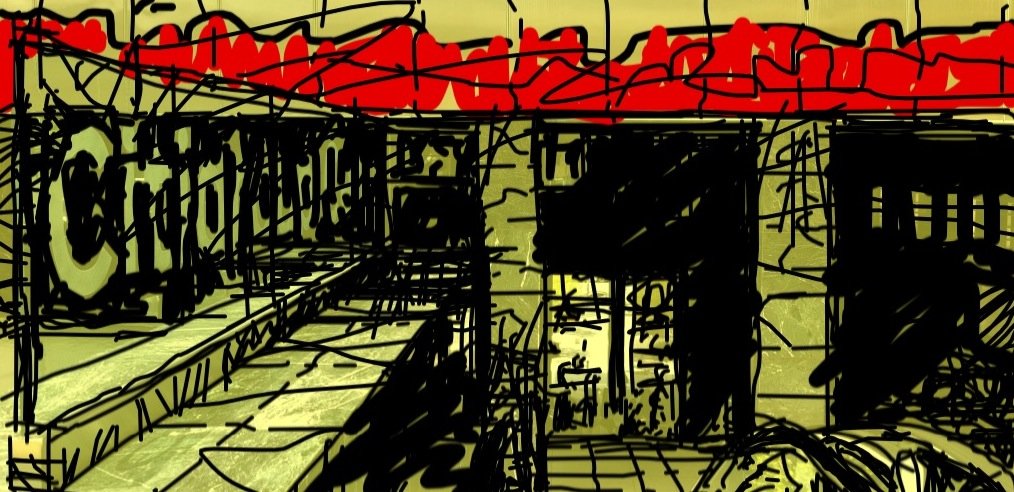VISITOR TO A CITY
Sketch: Doug Joyce
27 October 2012
A traveler, perhaps visiting a place for the first time, experiences some of the best and worst things of that locality. A visit experience creates its own microcosm of the city as a whole, a cross-section if its inner workings, a series of places and events that represents the whole. That person, thrown into the whirlwind, is hoping to grasp enough to make sense of everything to be able to navigate and to have a good and/or successful time during their visit. Impressions are arrived at from (sometimes) rapid fire events, and from the overall sensory stimulation of a new place. But the traveler also seeks to be able to quickly feel confident enough to progress beyond the sheer logistics of all of the maneuvering and initial practicalities, and off to the sights, sounds, and experiences.
THE ARRIVAL
Ending the voyage, moving around in the new environment, and arriving at the home destination (hotel, etc.) is attended to first. Is this a clear and pleasurable experience, or is it arduous and ugly, or even dangerous? The arrival is accomplished in any number of different ways. In North America, renting a car and attempting to figure out the directions, driving conventions, and attending to all of the requisite responsibilities of the vehicle that you've just acquired, is common. It often is also a recipe for torment, except if your destination is very suburban or rural. A public bus system, creaky and disorganized can be a formidable challenge to negotiate. A hire taxi or shuttle is also a potential adventure, filled with its own misunderstandings and public safety issues. The fortunate one has a dedicated ride from someone with a sign with their name on it, as a prelude to being whisked to their destination.
I like an easy-to-use rail system from the airport or other terminus that I have arrived at. I appreciate the procession into the city I'm visiting, mostly free of the personal mechanics of transportation, focusing on getting a feeling for the surroundings. Even on a subway system, I appreciate the process and approach, if the infrastructure is handled well. It is the transitioning into this new place that allows me to settle my mind. I get to my (clearly indicated) stop, make it out of the station with grace and the opportunity to get my feet on the ground, and top it off with a beautiful block or three walk to my Hotel, well, I feel pretty good. I already have a good attitude about the place I am visiting.
There are things like water taxis to take you from the airport to the center of Venice Italy that are pretty cool. And a taxi ride in New Orleans is interesting in a different way- there is a chain character to the people and a certain patina to the place that makes this an interesting exception to the rule. But many cities aren't up to having a good arrival experience, rail or otherwise. For all except the extreme travel warriors, first impressions of many places aren't that great.
THE WORLD OF THE VISITOR
Our traveler has reserved a place to stay, or perhaps needs to find one upon arrival. She needs to eat, and take care of various obligations of a business or personal nature. She quite likely would want to take in some of the unique things, cultural and otherwise as part of the experience of the journey. The people who directly receive these travelers are a major part of the experience. But sometimes it is the actual physical city, is as important. Every street tree and sidewalk, every taxi stand and transit terminal, every building face and hotel lobby contributes to this experience. If it is not thought through, and keeps a visitor from having a whole experience of a city, well, it becomes less than a satisfying experience.
A brief visit someplace does not usually consist of a comprehensive overview and visit of every neighborhood. You may have someone guide you around for an afternoon or a couple of days, but for the most part, your visit is constrained to a certain portion of the city, and it hopefully gives a proper representation of a whole city. On a recent trip to St Louis, I toured the historic Union Station there. A historic incident described in the tour was a story of a couple from a small Missouri town who visited the City on a holiday. It was the era where the station was the center of life of the City; it was a place where you could eat, be entertained, obtain luxury logging, shop, and pretty much take care of a lot of the normal needs of human existence. The couple observed the station as the whole city- they thought St Louis was a unique place, the only City they had ever been to that was contained all under one roof! The take-away is that even a small portion of a city can be satisfying if it is complete.
COMPLETE AND WHOLE
If a city is filled with all of the varying things of commerce and amenities, but can't offer it's inhabitants a complete experience- with transportation, and places to live, work, and recreate in reasonable proximity, it is not functioning as a complete and whole city. If the shape and form of the city are not a pleasure and inspiration to move through, then it isn't a fully formed city. The visitor judges a city, and determines if it provides a whole experience. But the people who inhabit a place need the same things, if it is going to be a place that we truly love and can function in.
We all need to look at the cities that we inhabit with the eye of the visitor.

